Canoes
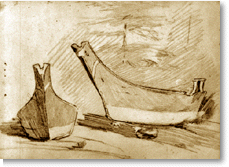 "I went in a small dugout Indian boat, and my companions were an Indian woman and her two children. She sat in the stern with the baby in her lap and steered, a small girl of 12 deftly manipulated the sail, a homemade affair of flour sacks. How well they do handle their boats, it seems born in them. It was a wild day and rained heavily, and I could only sketch between showers."
"I went in a small dugout Indian boat, and my companions were an Indian woman and her two children. She sat in the stern with the baby in her lap and steered, a small girl of 12 deftly manipulated the sail, a homemade affair of flour sacks. How well they do handle their boats, it seems born in them. It was a wild day and rained heavily, and I could only sketch between showers."
Carr Lecture on Totems 1913:38
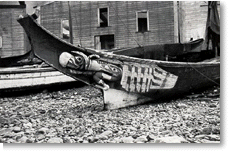 "As a youth, I saw the last few traditional Westcoast canoes still plying the waters of our Somass River. Those canoes, used mostly for fishing, hunting and spiritual questing, were as important to us economically and spiritually as wheeled vehicles are today. For me, they embodied constant alertness. They gave powerful image and substructure to the quest for spiritual strength. My first carvings, at age of ten, were model canoes. Alertness and strength in appearance and structure continue as my foremost concerns today, while carving model and full sized Westcoast canoes."
"As a youth, I saw the last few traditional Westcoast canoes still plying the waters of our Somass River. Those canoes, used mostly for fishing, hunting and spiritual questing, were as important to us economically and spiritually as wheeled vehicles are today. For me, they embodied constant alertness. They gave powerful image and substructure to the quest for spiritual strength. My first carvings, at age of ten, were model canoes. Alertness and strength in appearance and structure continue as my foremost concerns today, while carving model and full sized Westcoast canoes."
Ron Hamilton, Port Alberni 31 July 1999
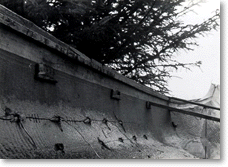
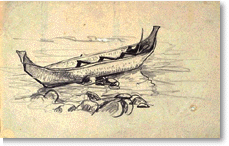
"The board walk fronts many community houses, each with its totem; between it and the sea are a few shacks, a few stores, but it is most open, and separated only by a beach of rounded pebbles. The beach is littered with logs, white, gray, and flesh-coloured--and amongst them are a few painted canoes, most graceful craft."
Phillips Wet Paint, n.d.: 98 and 100
"When a man wants to make a canoe, he goes into the woods to look for a large cedar-tree. He carries his chisel. . . . he looks for the branch side of the tree, and cuts it, that the tree may fall on the branches. The canoe-maker takes his chips and throws them at the place where he wants the cedar-tree to fall. As soon as he hears the wood cracking, he prays. 'Do not fall too heavily, else you, great magician, will be broken.' Then the cedar falls."
George Hunt in Boas 1909:344
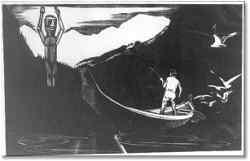
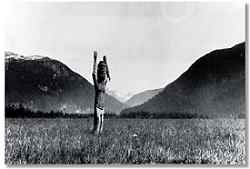
Historical accuracy was not Langdon Kihn's* primary concern in his role as illustrator. His pencil drawing shows a reasonably correct rendering of Chief Shakes' canoe, collected in 1893 and later deposited in the Smithsonian collection where Kihn would have sketched it. In his finished oil for the National Geographic Society, he has replaced the original bow painting with one designed by Haida artist Charles Edenshaw.
"One of these canoes was the property of Chief Shakes of the Stikine tribe. It has three names: 'Brown Bear Canoe,' . . .from the carved bear figures surmounting the bow and stern.. . . The second name was 'Killerwhale Canoe', . . . because a killerwhale was painted on either side, and the canoe was reckoned as a great killerwhale whose natural food is the seal. . . . On either side of the stern was painted a raven, . . . and so the canoe was also named 'Raven Canoe,' . . . the Killerwhale and Brown Bear were both family crests of the chief's clan; the Raven was the crest of his wife's clan."
-George T. Emmons 1991:86-88
*no images of works by Langdon Kihn, pending location of copyright holder(s)
On to an interview with Peter Macnair at Thunderbird Park
See more paintings of canoes
See more photographs of canoes
|

